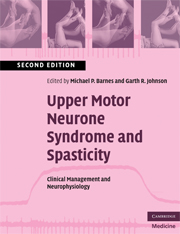Book contents
- Frontmatter
- Contents
- List of Contributors
- Preface to the second edition
- 1 An overview of the clinical management of spasticity
- 2 Neurophysiology of spasticity
- 3 The measurement of spasticity
- 4 Physiotherapy management of spasticity
- 5 Seating and positioning
- 6 Orthoses, splints and casts
- 7 Pharmacological management of spasticity
- 8 Chemical neurolysis in the management of muscle spasticity
- 9 Spasticity and botulinum toxin
- 10 Intrathecal baclofen for the control of spinal and supraspinal spasticity
- 11 Surgical management of spasticity
- 12 Management of spasticity in children
- Index
- References
6 - Orthoses, splints and casts
Published online by Cambridge University Press: 22 August 2009
- Frontmatter
- Contents
- List of Contributors
- Preface to the second edition
- 1 An overview of the clinical management of spasticity
- 2 Neurophysiology of spasticity
- 3 The measurement of spasticity
- 4 Physiotherapy management of spasticity
- 5 Seating and positioning
- 6 Orthoses, splints and casts
- 7 Pharmacological management of spasticity
- 8 Chemical neurolysis in the management of muscle spasticity
- 9 Spasticity and botulinum toxin
- 10 Intrathecal baclofen for the control of spinal and supraspinal spasticity
- 11 Surgical management of spasticity
- 12 Management of spasticity in children
- Index
- References
Summary
Introduction
As defined by the International Standards Organization, ‘An orthosis is an external device used to modify the structural or functional characteristics of the neuromuscular system’. This definition encompasses all other devices referred to as splints, braces and casts. Although not so well defined, it is common practice for clinicians to refer to orthoses as those external devices provided by an orthotist, while splints are commonly recognized as orthoses made of low-temperature plastics or fabric by therapists other than orthotists. Nonremovable orthoses made of plaster or casting tape are referred to as casts.
The use of orthoses (in all their forms) for adults presenting with spasticity has been controversial (ACPIN, 1988), and use varies from centre to centre depending on the treatment regime used by the therapist. However, in pediatrics, their use is more widely accepted, partially due to the work of Meadows (1984) in the early 1980s and those therapists using the Conductive Education techniques promoted by the Peto Institute.
In adult neurology, treatment is often based on the Bobath concept of normal movement (Bobath, 1980), which for many years frowned on the use of splinting because of the obvious impingement on the ability to perform normal movement.
Normal movement is the ultimate goal in neuro-rehabilitation. However, to expect all patients with a neurological deficit to make a full recovery is not realistic.
- Type
- Chapter
- Information
- Upper Motor Neurone Syndrome and SpasticityClinical Management and Neurophysiology, pp. 113 - 130Publisher: Cambridge University PressPrint publication year: 2008
References
- 2
- Cited by

